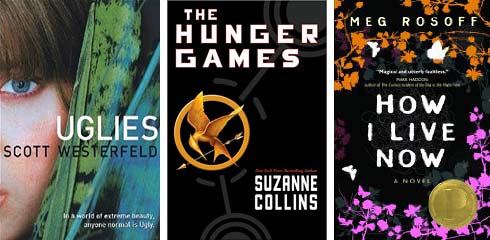…or if it is, it’s also dark and troubling. Much like the present, really, only different. Only worse.
Such is the primary lesson of today’s exploding subgenre of dystopian young adult fiction. I hesitate to make too many assertions about which books started this undeniable trend, or which books are included, because there’s a certain squishiness to how the term itself is used these days. It’s sometimes used to describe books I’d class as post-apocalyptic (Meg Rosoff’s How I Live Now, Janni Simner’s Bones of Faerie and—just out—Faerie Winter). Others have observed that it’s become more or less the YA field’s code word for “science fiction,” not so different from how “paranormal” is regularly used to mean any contemporary fantasy with a romance. This is a valid point; YA does seem to avoid the term science fiction. (Though I wonder how that will morph as YA SF books with less of a focus on dystopian elements become more common. And I believe they will. Beth Revis’ Across the Universe being a prime example; for all that there are hallmarks of dystopia there—the controlled society, the loss of individualism—it is primarily a generation ship story.) At any rate, argument over the term’s use or not, there are a steadily growing number of YA books that are indisputably dystopian in nature, with the wild success of The Hunger Games having kicked the trend into high gear.
This makes perfect sense to me. Thinking back to my own high school years, I adored Farenheit 451, 1984, and Brave New World when we read them for class, and (not for class) Margaret Atwood’s The Handmaid’s Tale. So I’d hold that teenagers and dystopian works have always gone together. Over the past decade and the explosion of YA itself as a field, I believe the renaissance (or birth, however you want to look at it) of this subgenre being written for teens began with Scott Westerfeld’s Uglies trilogy. If anyone’s unfamiliar with these books, they follow the journey of Tally Youngblood in a future version of our world where at 16 everyone is made “pretty” and goes to live in New Pretty Town. Of course, they aren’t just making you pretty, and there’s an organized resistance movement, and the beautiful ruins of our own dead society. The books hit the nerve center of our culture’s obsession with looks over substance, while exploring the danger of conformity and a host of related issues.
In fact, many titles speak directly to historical strains of dystopian literature in SF. I relied on The Encylopedia of Science Fiction’s entry (written by Brian Stableford) as a primer. The entry talks about how “revolution against a dystopian regime” often turned into a plot with “an oppressive totalitarian state which maintains its dominance and stability by means of futuristic technology, but which is in the end toppled by newer technologies exploited by revolutionaries.” This seems to me to nearly describe Suzanne Collins’ The Hunger Games or Cory Doctorow’s Little Brother—although, in both those instances, it’s not so much new technology as the heroes effectively using the existing technology against the totalitarian regime. (Or, for Doctorow’s part, inventive new uses of that technology.) And, if Paolo Bacigalupi’s Ship Breaker doesn’t allow for any major overthrow of the society’s leaders, it is undoubtedly exploring a distorted landscape, environmentally and socially, a direct callback to another primary strain of dystopia. The Encyclopedia talks about post-WWII dystopian writing that has “lost its faith in the probability of a better future, and the dystopian image was established as an actual pattern of expectation rather than as a literary warning device.” The grim world of Ship Breaker seems to be clearly speculative from our current reality, though Paolo has said elsewhere that part of the reason the novel is more hopeful than his work for adults is because teens still have a chance to improve things. All of these dark futures come standard with philosophical and political themes; all of them believe in the possibility for change.
At the end of Laura Miller’s New Yorker essay about YA dystopians, she wondered if the anxieties showcased in most of the books aimed at teens are truer reflections of the ones their authors feel. While this may be a factor, I think most—the best—YA writers are tapped into what it feels like to be a teenager (something that really doesn’t change that much from decade to decade). So I suspect the core reason these books connect so well with teens—many of them even with the potential to be that holy grail of YA, appealing to girls and to boys—is that most of them are, at heart, about pulling apart the oppressive assumption and the unexplained authority, and then rebelling against it. Tearing it apart. In a world where choosing what to rebel against seems impossible for every generation (“What do you got?”), stories set in worlds where the decision is easy and justified will never lose their appeal.
There’s this popular view of teenagers as intellectually lazy (because they text or something? I don’t know) and politically uninvolved. I’d argue that the popularity of dystopians exposes the lie beneath both these, well, lies. These novels may spring from the anxieties of older people, but they are cultural anxieties—and teens are also members of our culture. The beauty of well-aimed dystopia for teens is that it can potentially have a direct effect on what it’s arguing against, by speaking directly to the people best suited to alter the future. Maybe things don’t look so bleak after all.
Gwenda Bond writes YA fantasy, among other things, and can be found at her blog and on Twitter.










